 |
 |
 |
| |
Lower Peak Viral Load, Higher CD4/CD8 Ratio Linked to Low PBMC Reservoir
|
| |
| |
7th IAS Conference on HIV Pathogenesis, Treatment and Prevention, June 30-July 3, 2013, Kuala Lumpur
Mark Mascolini
A lower peak viral load in plasma, a current plasma load below 1 copy/mL, and a higher (better) CD4/CD8 ratio predicted low HIV DNA in peripheral blood mononuclear cells (PBMCs) in antiretroviral-treated people [1]. Neither duration of antiretroviral therapy nor duration of undetectable plasma load predicted low HIV DNA in PBMCs.
HIV DNA integrated into PBMCs remains untouched by conventional antiretroviral therapy and represents a key viral reservoir. Activation of latently infected PBMCs can spill virus back into circulation. Recent research indicates that treating acute HIV infection can limit the PBMC reservoir, but factors affecting the size of this reservoir in chronically infected people remain poorly understood. To address that question, researchers in Paris conducted this cross-sectional study of chronically infected people with long-term HIV RNA in plasma below 50 copies.
The researchers noted that quantitative coculture is the classic method for measuring HIV in latently infected cells. Because this approach is expensive and time consuming, they measured total HIV DNA as a surrogate for calculating the PBMC reservoir, acknowledging that total HIV DNA may overestimate reservoir size because most HIV DNA is defective.
The study involved 243 people with a plasma load below 50 copies after at least 6 months of antiretroviral therapy. No one began treatment during acute infection. All participants had total cell-associated HIV DNA measured to see how many had an HIV DNA load below 100 copies per million PBMCs, the level typically seen in HIV elite controllers (people who maintain an undetectable plasma load without antiretroviral therapy). By univariate analysis, the Paris team selected factors associated with a sub-100-copy load at P < 0.1 for a multivariate model to identify independent predictors of low HIV DNA in PBMCs.
The 243 study participants had a median age of 47 years, and 68 (28%) were women. Median time since HIV diagnosis stood at 12 years (interquartile range [IQR] 6 to 18), median time on therapy at 9 years (IQR 4 to 13), and median time with an undetectable plasma load at 3.1 years (IQR 0.9 to 5.4). Median nadir CD4 count was 216 (IQR 107 to 339) and median peak viral load 5.028 log10 copies (a little over 100,000 copies). Current median CD4 count stood at 583 (IQR 379 to 779) and median CD4/CD8 ratio at 0.778 (IQR 0.531 to 1.195). A CD4/CD8 ratio between 1 and 4 is considered normal.
Among 212 people who had ultrasensitive HIV RNA testing, 130 (61%) had a load below 1 copy/mL. In this subgroup, median HIV DNA in PBMCs stood at 372 copies per million cells. Fifty-eight of 212 people (27%) had an HIV DNA level below 100 copies per million PBMCs. Multivariate analysis determined that every 10-fold higher peak plasma load diminished chances of a PBMC load under 100 copies almost 60%. A plasma load below 1 copy tripled chances of a sub-100 PBMC load, and higher CD4/CD8 ratio more than doubled chances of a sub-100 PBMC load:
Independent predictors of PBMC load below 100 copies per million cells (odds ratios and 95% confidence intervals):
-- Each 10-fold higher peak plasma load: OR 0.42, 95% CI 0.26 to 0.64, P = 0.0001
-- HIV RNA in plasma below 1 copy: OR 2.97, 95% CI 1.21 to 8.12, P = 0.0228
-- Higher current CD4/CD8 ratio: OR 2.31, 95% CI 1.12 to 4.80, P = 0.0227
Factors that did not affect chances of a sub-100 PBMC load in this analysis included age, gender, nadir CD4 count, duration of antiretroviral therapy, time with a plasma load below 50 copies, and current CD4 or CD8 count.
The researchers proposed that the links between lower peak viral load, CD4/CD8 ratio, and low PBMC load reinforce "the need to institute antiretroviral treatment early during infection [to promote] better recovery of [the] CD4/CD8 ratio." They suggested that the link between low plasma load and low PBMC load may indicate that stronger control of residual viremia limits immune activation.
The investigators proposed that strategies aiming to control residual viremia in antiretroviral-treated people should be pursued as an approach to reducing the size of the PBMC reservoir.
Reference
1. Fourati S, Calin R, Carcelain G, et al. Factors associated with a low HIV reservoir in patients with prolonged suppressive antiretroviral therapy. 7th IAS Conference on HIV Pathogenesis, Treatment and Prevention, June 30-July 3, 2013, Kuala Lumpur. Abstract WEPE443.
For the complete poster: http://pag.ias2013.org/EPosterHandler.axd?aid=1436
-----------------------------------




|
| |
|
 |
 |
|
|